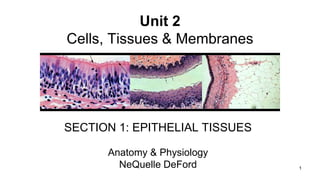
Epithelial Tissue PPT
- 1. 1 Unit 2 Cells, Tissues & Membranes SECTION 1: EPITHELIAL TISSUES Anatomy & Physiology NeQuelle DeFord
- 2. 2 • Epithelial tissue is a sheet of cells that covers a body surface or lines a body cavity. • Includes epithelia and glands –Epithelia are layers of cells that cover internal or external surfaces –Glands are composed of secreting cells derived from epithelia Epithelial Tissue
- 3. 3 1. Cellularity: Composed almost entirely of cells (all cells tightly bound by cell junctions), forming a continuous sheet. 2. Avascular: Containing no blood vessels. 3. Innervated: Supports nerve fibers. 4. Regeneration: Epithelial cells are frequently damaged or lost to abrasion, so they are replaced quickly 5. Polarity: Apical (free) and basal surfaces (attached to underlying connective tissue) Epithelial Tissues: Characteristics
- 5. 5 1. Protection: Epithelial cells protect underlying tissue from mechanical injury, harmful chemicals and pathogens and dehydration. 2. Sensation: Changes in the environment are detected by specialized epithelial cells found in the skin, eyes, ears, and nose, and on the tongue. 3. Secretion: In glands, epithelial tissue is specialized to secrete specific chemical substances such as enzymes, hormones and lubricating fluids. Epithelial Tissues: 8 Major Functions
- 6. 6 4. Excretion: Epithelial tissues in the kidney excrete waste products from the body and reabsorb needed materials from the urine. Sweat is also excreted from the body by epithelial cells in the sweat glands. 5. Diffusion: Simple epithelium promotes the diffusion of gases, liquids and nutrients. Because they form such a thin lining, they are ideal for the diffusion of gases (e.g. walls of capillaries and lungs). Epithelial Tissues: 8 Major Functions
- 7. 7 6. Absorption: Certain epithelial cells lining the small intestine absorb nutrients from the digestion of food. 7. Contractility: Some very specialized epithelial cells, found in the lining of the heart and respiratory tract, contain the contractile proteins myosin and actin, similar to muscle. 8. Transportation: Some epithelial cells have cilia, short hair-like projections that propel fluid or particulate matter over tissue surfaces. Epithelial Tissues: 8 Major Functions
- 8. 8 To be effective in protecting other tissues, epithelial cells must remain firmly attached to the basement membrane and to one another to form a complete cover or lining. A cell junction is a specialized attachment site on a cell that allows for support and communication. Four common intercellular connections are tight junctions, adhering junctions, gap junctions, and anchoring junctions (desmosomes). Epithelial Tissues: Intercellular Connections
- 9. 9 Tight junctions anchor cells to each other – prevents substances from passing between cells – materials must move through cells, or are blocked from moving past cells – found in intestinal lining Epithelial Tissues: Intercellular Connections Tight junction
- 10. 10 Adhering junctions are often deep to tight junctions – form all the way around the cell – support apical surface – allow passage between cells below the apical surface Epithelial Tissues: Intercellular Connections Adhering junction
- 11. 11 Gap junctions tunnel between two plasma membranes – found in muscles – enables sharing of ions and proteins – enables fast communication between cells Epithelial Tissues: Intercellular Connections Gap junction
- 12. 12 Epithelial Tissues: Intercellular Connections Anchoring junction Anchoring junctions attach cells to each other – bind epithelium together – bind muscle cells – resists shear force – allow bending and twisting
- 13. 13 In some epithelial tissue, basal cells are anchored to the basement membrane with a specialized type of anchoring junction called a hemidesmosome. Epithelial Tissues: Intercellular Connections Hemidesmosome
- 14. 14 Epithelial Tissues: Intercellular Connections
- 15. 15 The basement membrane has no cells but is a network of protein fibers that connect adjacent epithelial cells to underlying connective tissues. Epithelial Tissues: Basement Membrane
- 16. 16 • Epithelial cells may only survive for a day or two because they are lost or destroyed. • Replaced by continuous division of unspecialized cells called stem cells. • Stem cells are found in deepest layer next to basement membrane. Epithelial Tissues: Renewal and Repair
- 17. 17 Each epithelium tissue is given two names: • The first name indicates the number of cell layers present. – Simple- one layer (used in filtration) – Stratified- more than one layer (wear and tear areas) – Pseudostratified- one layer that looks like many (areas that need to stretch) • The second describes the shape of its cells – Squamous- cells are wider than tall – Cuboidal- cells are as wide as tall – Columnar- cells are taller than wide – Transitional- cells have no specific shape • Ciliated- If the apical edge of the epithelium has cilia Epithelial Tissues: Classification
- 18. 18
- 19. 19 Glandular Epithelia Many epithelia contain gland cells that produce exocrine or endocrine secretions 1. Exocrine Glands – produce exocrine secretions and discharge their products through a duct/tube, onto some external or internal surface. Gland can be unicellular (goblet cell) or multicellular. Ex. sweat glands, oil glands, mammary glands, liver, and pancreas 2. Endocrine Glands– are produced by ductless glands and released into blood or tissue fluids. Ex. hormones (chemical messengers that regulate or coordinate the activities of other tissues, organ and organ systems). Glandular Epithelia
- 20. • Merocrine Secretion – exocytosis, product oozes out of cell (ex. sweat gland) • Apocrine Secretion – part of cell pinches off, releasing secretion (ex. mammary gland) • Holocrine Secretion – superficial cell fills with secretion, bursts open and dies, releasing secretion (ex. sebaceous gland) 20 Modes of Exocrine Secretion